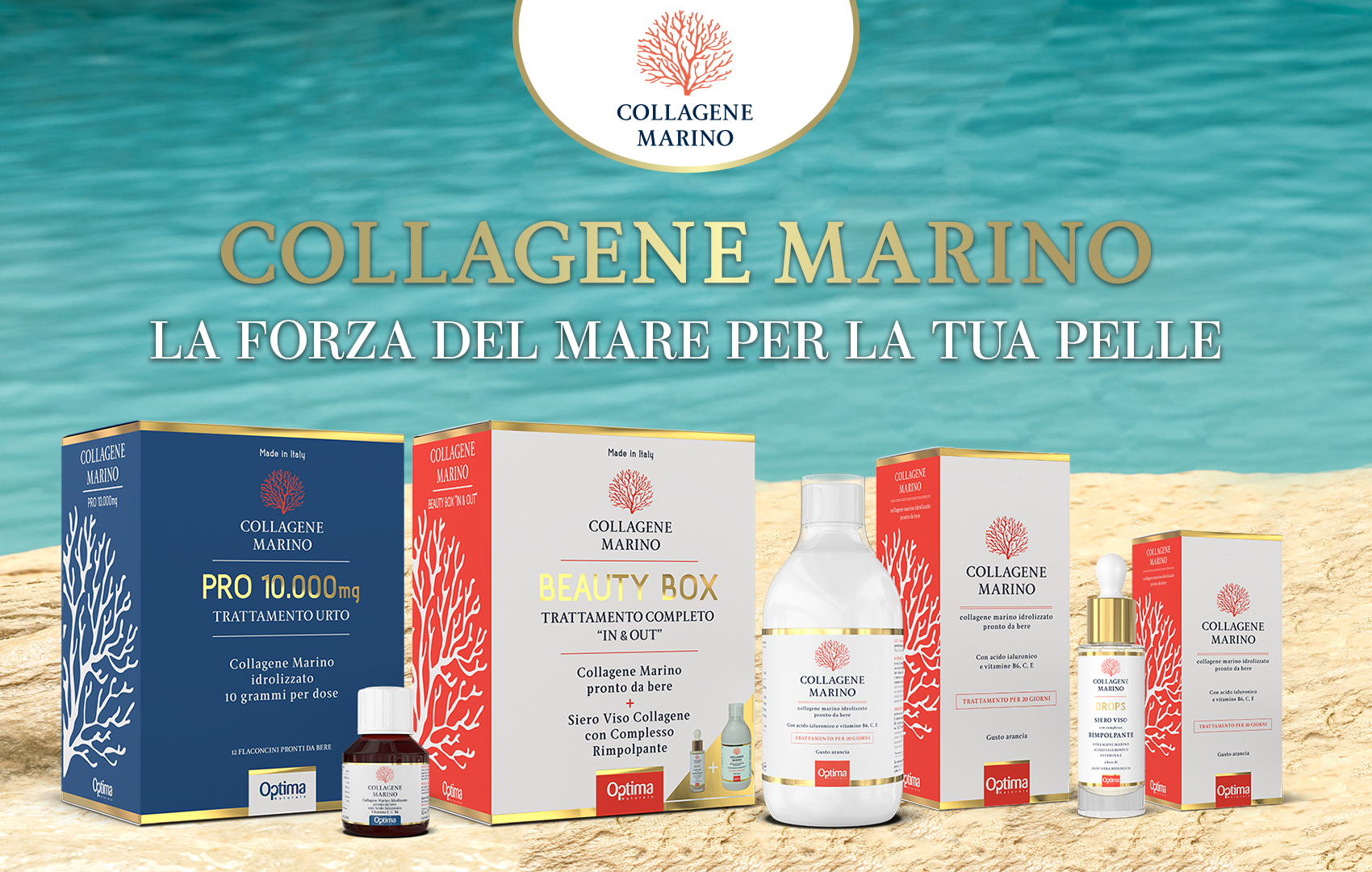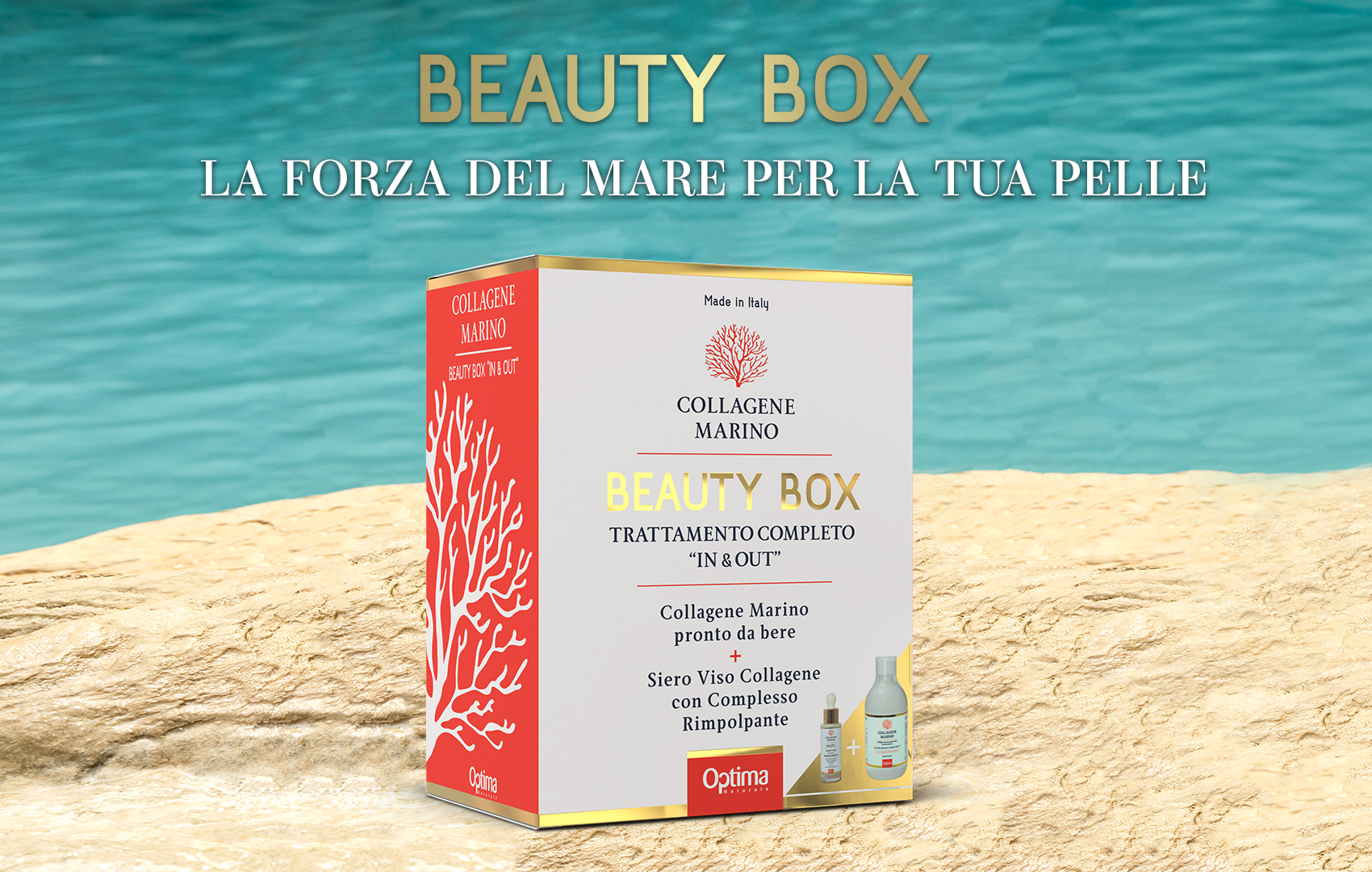No products
Categories
- Fashion Accessories
- Clothing
- Beauty & Lifestyle
-
Hi-Tech & Lifestyle
- Gaming
-
Case
- iPhone 11 Pro
- iPhone 11 Pro Max
- iPhone 11
- iPhone X / XS
- iPhone XS Max
- Samsung S10 / S10+ / S10e
- Huawei P30 / P30 Pro / P30 Lite
- Huawei P20 / P20 Pro / P20 Lite
- iPhone XR
- Samsung S9
- Samsung S9+
- iPhone 8 / 7
- iPhone 8 Plus / 7 Plus
- Samsung S8
- Samsung S8+
- Samsung S7
- Samsung S7 Edge
- iPhone 6 / 6 s
- iPhone 6 Plus / 6 s Plus
- iPhone 5 / SE
- Skin
- Audio
- Smart Home
- Drones & Hoverboard
- Photo & Video
- Desk Supplies
- Accessories
- Games
- Beverages
- Food
- Home
- Jewelry
- Luxury
- Travel
- Art
- Footwear
- Vintage Fashion
- Restaurants
- Sport
- Animals
- Gift Ideas
- Kidswear
Extra
Optima Naturals
The Power of the Sea for Your Skin

Marine Collagen

What is Collagen?

Collagen is a fibrous protein normally abundant in the human body, in fact, at a young age, it constitutes about a third of body weight and is the main structural protein of connective tissues (skin, tendons, cartilage, bones and teeth ...). The fundamental unit of collagen is tropocollagen, which has an elongated triple helix structure, which determines its particular resistance to tension. The typical amino acid composition of tropocollagen includes glycine 33 %, proline + hydroxyproline 27 %, the rest is represented by all amino acids, except cysteine and tryptophan which are absent.

From scientific literature there are 28 types of collagen, some more widespread than others in the different connective tissues: type I collagen, for example, represents 90% of the total collagen and mainly consists of skin, tendons, bones and cornea. Collagen fibers, forming a complex network at the level of the dermis, give integrity and structural support to the epidermis. In addition, collagen, together with elastin, forms the extracellular matrix, which gives structure, elasticity and firmness to the skin.

Collagen is mainly produced by fibroblasts, connective cells present in the dermis, responsible for the production and organization of the matrix. Fibroblasts are sensitive to physical and chemical stimuli, which induce both the activation and the proliferation of these cells. The result of their activation is an increase in collagen production.

The efficiency of the physiological process of collagen synthesis can be compromised; the skin is in fact subject to deterioration due to aging processes, environmental factors (pollution, UV rays ...), an unbalanced diet and an incorrect lifestyle (smoking, excessive alcohol consumption, stress, lack of sleep). Furthermore, some studies have shown that the synthesis and proportion of the different types of collagen also changes in the different phases of life; young skin is made up of 80% type I collagen and about 15 % type III collagen. With advancing age, collagen replenishment efficiency decreases by approximately 1.5 % each year. The results of this wasting process are a decrease in the density of collagen and elastin in the dermis, resulting in less elasticity of the skin, less thickness and less compactness.

To slow down these aging processes, it is good to maintain a varied and balanced diet, a healthy lifestyle and correct integration, to ensure the correct intake of macro and micro-nutrients in order to support the physiological processes of body. Several studies have also shown the effectiveness of supplementing hydrolyzed collagen to restore the skin to a better appearance, increasing its hydration levels, restoring its elasticity, brightness and reducing the signs of aging.
Why Integrate with Hydrolyzed Collagen?

Hydrolyzed collagen is composed of small peptides with a low molecular weight (0.3-0.8 kDa), obtained by an enzymatic hydrolysis process. The peptides thus obtained are more digestible and better absorbed, demonstrating various benefits on health in general and on the skin in particular.

Hydrolyzed collagen is very rich in specific amino acids, in particular glycine, proline and hydroxyproline. To be active in the deep layers of the skin, hydrolyzed collagen must be further broken down following digestive processes in the stomach and intestines. The first digestion step consists in the degradation of the hydrolyzed collagen into dipeptides and tripeptides, or free amino acids. Several proteases (eg pancreatic proteases, intestinal proteases at the edge of the brush border, peptidases) are involved in this degradation process.

Following this cleavage, these molecules are able to cross the intestinal barrier and reach the bloodstream. The speed of transport through the intestinal barrier could be a control phase that influences the effectiveness of these compounds in the skin, so it is important to demonstrate that the collagen peptides are absorbed, but also in what form and in what quantity. In some clinical studies, the blood concentration of collagen peptides and single amino acids following the intake of collagen was also investigated. It was found that a dipeptide, proline-hydroxyproline (Pro-Hyp), was found in the blood, in a concentration equal to 25-60 nmol / ml of plasma, following ingestion of 9.4-23 g hydrolyzed collagen.

Some in vivo studies have instead studied the distribution of collagen peptides in the skin and other tissues, by radioactive labeling with C-14 of proline or collagen peptides administered to Wistar rats. Radioactivity was measured in different tissues at t = 0 and t = 6 hours after the ingestion of collagen and for the following 14 days. The results proved promising in terms of collagen residence time in the skin, recording very high levels of radioactivity for the duration of the test. This demonstrates the ability of collagen peptides to reach the dermis in the skin, where the benefits are most evident.

In two other randomized and double-blind placebo-controlled clinical trials, the increase in skin hydration levels and decrease in deep wrinkles were investigated. In the first, conducted on 33 women aged between 40 and 59 with normal to dry skin, there was a 28% increase in hydration levels with a daily consumption of 10 g of hydrolyzed collagen and a decrease in deep wrinkles. by 30 %.
Collagen Yes. But Which One?

In light of the positive scientific results regarding the effectiveness of taking hydrolyzed collagen to restore the health of the skin, the choice of which product to choose arises. There are dozens of collagen-based products on the market, but they are not all the same.

The first discriminant is precisely the collagen itself, or rather, the source from which it is derived. In fact, there is collagen of bovine and porcine origin, derived from chicken and derived from fish. There is also a vegetable variant, extensin, a protein contained in cereals, soybeans, algae, incorrectly defined as "vegetable collagen", given its high hydroxyproline content, but which is not comparable to collagen proper.
But Why Marine Collagen?

Compared to collagen from other animal sources, marine has lower gelling and melting temperatures, maintaining a viscosity equal to that of bovine. The amino acid composition is richer in serine, threonine and methionine; there is also a high level of glycine and significant levels of proline and hydroxyproline. Due to its composition, marine collagen is more soluble, digestible and more easily assimilated by the body. From Optima Naturals research, Marine Collagen is born, a line characterized by collagen of marine origin, to guarantee high quality and efficacy to consumers who are directed towards the consumption of collagen, both as a dietary supplement and as a cosmetic.
Optima Naturals
The Power of the Sea for Your Skin

Marine Collagen

What is Collagen?

Collagen is a fibrous protein normally abundant in the human body, in fact, at a young age, it constitutes about a third of body weight and is the main structural protein of connective tissues (skin, tendons, cartilage, bones and teeth ...). The fundamental unit of collagen is tropocollagen, which has an elongated triple helix structure, which determines its particular resistance to tension. The typical amino acid composition of tropocollagen includes glycine 33 %, proline + hydroxyproline 27 %, the rest is represented by all amino acids, except cysteine and tryptophan which are absent.

From scientific literature there are 28 types of collagen, some more widespread than others in the different connective tissues: type I collagen, for example, represents 90% of the total collagen and mainly consists of skin, tendons, bones and cornea. Collagen fibers, forming a complex network at the level of the dermis, give integrity and structural support to the epidermis. In addition, collagen, together with elastin, forms the extracellular matrix, which gives structure, elasticity and firmness to the skin.

Collagen is mainly produced by fibroblasts, connective cells present in the dermis, responsible for the production and organization of the matrix. Fibroblasts are sensitive to physical and chemical stimuli, which induce both the activation and the proliferation of these cells. The result of their activation is an increase in collagen production.

The efficiency of the physiological process of collagen synthesis can be compromised; the skin is in fact subject to deterioration due to aging processes, environmental factors (pollution, UV rays ...), an unbalanced diet and an incorrect lifestyle (smoking, excessive alcohol consumption, stress, lack of sleep). Furthermore, some studies have shown that the synthesis and proportion of the different types of collagen also changes in the different phases of life; young skin is made up of 80% type I collagen and about 15 % type III collagen. With advancing age, collagen replenishment efficiency decreases by approximately 1.5 % each year. The results of this wasting process are a decrease in the density of collagen and elastin in the dermis, resulting in less elasticity of the skin, less thickness and less compactness.

To slow down these aging processes, it is good to maintain a varied and balanced diet, a healthy lifestyle and correct integration, to ensure the correct intake of macro and micro-nutrients in order to support the physiological processes of body. Several studies have also shown the effectiveness of supplementing hydrolyzed collagen to restore the skin to a better appearance, increasing its hydration levels, restoring its elasticity, brightness and reducing the signs of aging.
Why Integrate with Hydrolyzed Collagen?

Hydrolyzed collagen is composed of small peptides with a low molecular weight (0.3-0.8 kDa), obtained by an enzymatic hydrolysis process. The peptides thus obtained are more digestible and better absorbed, demonstrating various benefits on health in general and on the skin in particular.

Hydrolyzed collagen is very rich in specific amino acids, in particular glycine, proline and hydroxyproline. To be active in the deep layers of the skin, hydrolyzed collagen must be further broken down following digestive processes in the stomach and intestines. The first digestion step consists in the degradation of the hydrolyzed collagen into dipeptides and tripeptides, or free amino acids. Several proteases (eg pancreatic proteases, intestinal proteases at the edge of the brush border, peptidases) are involved in this degradation process.

Following this cleavage, these molecules are able to cross the intestinal barrier and reach the bloodstream. The speed of transport through the intestinal barrier could be a control phase that influences the effectiveness of these compounds in the skin, so it is important to demonstrate that the collagen peptides are absorbed, but also in what form and in what quantity. In some clinical studies, the blood concentration of collagen peptides and single amino acids following the intake of collagen was also investigated. It was found that a dipeptide, proline-hydroxyproline (Pro-Hyp), was found in the blood, in a concentration equal to 25-60 nmol / ml of plasma, following ingestion of 9.4-23 g hydrolyzed collagen.

Some in vivo studies have instead studied the distribution of collagen peptides in the skin and other tissues, by radioactive labeling with C-14 of proline or collagen peptides administered to Wistar rats. Radioactivity was measured in different tissues at t = 0 and t = 6 hours after the ingestion of collagen and for the following 14 days. The results proved promising in terms of collagen residence time in the skin, recording very high levels of radioactivity for the duration of the test. This demonstrates the ability of collagen peptides to reach the dermis in the skin, where the benefits are most evident.

In two other randomized and double-blind placebo-controlled clinical trials, the increase in skin hydration levels and decrease in deep wrinkles were investigated. In the first, conducted on 33 women aged between 40 and 59 with normal to dry skin, there was a 28% increase in hydration levels with a daily consumption of 10 g of hydrolyzed collagen and a decrease in deep wrinkles. by 30 %.
Collagen Yes. But Which One?

In light of the positive scientific results regarding the effectiveness of taking hydrolyzed collagen to restore the health of the skin, the choice of which product to choose arises. There are dozens of collagen-based products on the market, but they are not all the same.

The first discriminant is precisely the collagen itself, or rather, the source from which it is derived. In fact, there is collagen of bovine and porcine origin, derived from chicken and derived from fish. There is also a vegetable variant, extensin, a protein contained in cereals, soybeans, algae, incorrectly defined as "vegetable collagen", given its high hydroxyproline content, but which is not comparable to collagen proper.
But Why Marine Collagen?

Compared to collagen from other animal sources, marine has lower gelling and melting temperatures, maintaining a viscosity equal to that of bovine. The amino acid composition is richer in serine, threonine and methionine; there is also a high level of glycine and significant levels of proline and hydroxyproline. Due to its composition, marine collagen is more soluble, digestible and more easily assimilated by the body. From Optima Naturals research, Marine Collagen is born, a line characterized by collagen of marine origin, to guarantee high quality and efficacy to consumers who are directed towards the consumption of collagen, both as a dietary supplement and as a cosmetic.
-
Optima Naturals - Marine Collagen - Beauty Box - In & Out - Anti Aging...
And for a complete treatment, a winning combination is born for a deep and effective anti-aging action.
68,00 € -
Optima Naturals - Marine Collagen Pro 10,000 Mg - Urto Treatment - Natural...
The only one to provide 10 grams of collagen with a single dose. A rich, exclusive formula in a precious and captivating pack containing 12 single-dose vials ready to drink for a controlled intake and guaranteed efficacy.
68,00 € -
Optima Naturals - Hydrolyzed Liquid Marine Collagen - Bio Anti Aging...
From Optima Naturals research, Marine Collagen is born, a line characterized by collagen of marine origin, to guarantee high quality and efficacy to consumers who are directed towards the consumption of collagen, both as a dietary supplement and as a cosmetic.
48,00 € -
Optima Naturals - Marine Collagen Drops Face - Bio Anti Aging Treatment -...
A face serum formulated with an innovative complex with a plumping action, which, in synergy with Marine Collagen and Hyaluronic Acid, helps to fill expression lines and make the facial skin toned and compact. Organic Green Tea extract and Vitamin E complete the formulation, as they help fight free radicals and prevent cellular aging.
32,00 €






